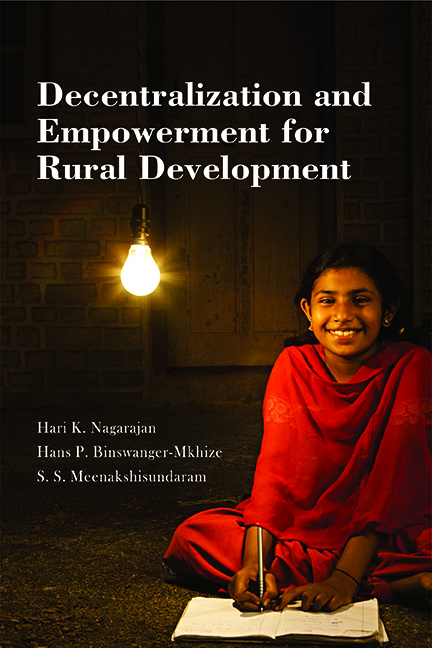Book contents
- Frontmatter
- Contents
- List of Tables and Figures
- Foreword 1
- Foreword 2
- Preface
- 1 Introduction
- 2 Decentralization: Cross-country Experiences
- 3 Thinking about Decentralization in India: 73rd Amendment and Beyond
- 4 Literature
- 5 An Overview of the Data
- 6 Analytical Approaches and Econometric Methods Used
- 7 Can Panchayats Improve the Quality of Services? Some Qualitative Evidence
- 8 Impact of Political Reservations for Women in Panchayats
- 9 Importance of Individual Empowerment of Women
- 10 Governance, Service Provision and Development Outcomes
- 11 The Impact of Fiscal Grants on Tax Efforts of Village Panchayats
- 12 Incidence of Identity-based Voting and Bribes in Panchayats
- 13 Panchayats and Household Vulnerability
- 14 Key Findings, Conclusions and Policy Recommendations
- References
- Index
- About the Authors
6 - Analytical Approaches and Econometric Methods Used
Published online by Cambridge University Press: 30 November 2022
- Frontmatter
- Contents
- List of Tables and Figures
- Foreword 1
- Foreword 2
- Preface
- 1 Introduction
- 2 Decentralization: Cross-country Experiences
- 3 Thinking about Decentralization in India: 73rd Amendment and Beyond
- 4 Literature
- 5 An Overview of the Data
- 6 Analytical Approaches and Econometric Methods Used
- 7 Can Panchayats Improve the Quality of Services? Some Qualitative Evidence
- 8 Impact of Political Reservations for Women in Panchayats
- 9 Importance of Individual Empowerment of Women
- 10 Governance, Service Provision and Development Outcomes
- 11 The Impact of Fiscal Grants on Tax Efforts of Village Panchayats
- 12 Incidence of Identity-based Voting and Bribes in Panchayats
- 13 Panchayats and Household Vulnerability
- 14 Key Findings, Conclusions and Policy Recommendations
- References
- Index
- About the Authors
Summary
In this chapter, the analytics associated with the findings reported in this book have been selectively discussed. In various chapters of this book, we analyse choices of individuals and households, such as the type of schools chosen for their children, payment of bribes, voting, attendance at gram sabha meetings, coping strategies, etc. The choices made by the panchayats such as expenditures, problem solving and provision of public goods and services are also evaluated and, outcomes of the choices made by the households and the panchayats are subsequently measured. The latter include quality and quantity of public services, access to welfare programmes, transitions out of poverty, literacy rates, consumption and incomes. Outcomes are measured at the individual, household and the village levels. Similarly, the variables affecting these outcomes are measured variously at the member, household, village and on occasions at the panchayat, the taluk, the district and the state levels.
Some examples of the type of analysis done include measuring the impact of various types of grants received by the panchayats on tax revenues, impact of school choice by households on literacy rates, estimating the impact of political reservations for women on the quality and process of governance, and the impact of institutions on coping strategies undertaken by households.
In order to analyse the causal links between the choices of individuals, households or local governments and outcomes, economists often build simplified optimizing or bargaining models that are used to gain insights into the structure of the problem analysed. These models will then form the basis for inferring expected signs and the magnitudes of impacts. The models are built to be theoretically consistent. The empirical estimation equations that emerge from this structure are the ‘reduced form equations’ because the structure of the underlying problem has been reduced to an estimation equation. If the structure is well defined, then structural parameters can be recovered from the estimated equations, which will help in understanding the pathways of the impacts to be analysed.
It has often been noted that different structures can lead to similar or identical reduced form equations. Nevertheless, the reduced form equations often produce coefficient estimates that are directly policy relevant. For example, change in panchayat expenditures arising out of untied funds can be estimated to have increased infrastructure investment, suggesting that the magnitude of untied grants should be increased to accelerate infrastructure investment.
- Type
- Chapter
- Information
- Decentralization and Empowerment for Rural Development , pp. 119 - 126Publisher: Foundation BooksPrint publication year: 2014

